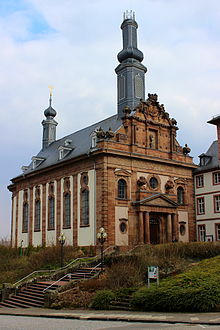Peter Reheis

Peter Reheis (born March 2, 1739 in Arzweiler , † July 3, 1804 in Blieskastel ) was a master builder . He worked as a count's building inspector and building director in Blieskastel.
Life
His parents were Georg Reheis and Maria Katharina Reheis nee Schneider in Arzweiler, which at the time of his birth belonged to the Lixheim rule in the Duchy of Lorraine and to the French department of Meurthe at the time of his death . Peter learned the mason and stone mason trade from the proper master Peter Ohl . An apprenticeship certificate from the bricklayer and stone mason guild in Maursmünster , which has still been received, certifies that he started his apprenticeship on December 27, 1762, completed the three-year apprenticeship period and became a journeyman on 29 August 1765.
Little is known about his further training. After completing his apprenticeship, he was involved in the construction of the Protestant Ludwig Church in Saarbrücken in 1766 , which the baroque master builder Friedrich Joachim Stengel built from 1762 to 1775. The apprenticeship letter issued at his request on February 3, 1774 names him a bricklayer and stone-cutter journeyman. The time of Reheis's master craftsman examination, his marriage to Anna Maria Both from Bliesschweyen († July 21, 1804 in Blieskastel) and his settlement in the Blieskastel area may be between 1774 and 1778, because from 1778 to 1799 the couple had eleven children in Blieskastel born.
After Count Franz Karl von der Leyen had relocated his residence from Koblenz to Blieskastel in 1773, the official residence of Blieskastel was transformed into a magnificent small residential town within 20 years with numerous new public buildings. The count died in 1775, but his widow, Marianne von der Leyen , née von Dalberg (a sister of the Prince Archbishop of Mainz and Imperial Chancellor von Dalberg ), continued to expand the royal seat. In addition to Christian Ludwig Hautt , Peter Reheis was particularly involved. In 1786 and thereafter, Peter Reheis is attested as the count's building inspector or building director in the service of the countess. The Countess gave Reheis her oil portrait and that of her son Philipp in recognition of his services in February 1786.
Reheis was responsible for the structural redesign and maintenance of the castle and all of the count's buildings. His tasks also included monitoring the manorial mines, iron works and glass works. The orphanage and workhouse were under his direction. In his hands the entire construction of the town and rule of Blieskastel lay. Building enthusiasts had to submit building plans that had to be checked and approved by Reheis. A house directory from 1792 shows Reheis as the owner of house no. 150 at today's "Paradeplatz" in Blieskastel, a two-story house worth 3000 guilders at the time .
The career and work of Peter Reheis came to an end after the outbreak of the French Revolution when the First Coalition War hit the border region hard. When the countess fled into exile in Frankfurt in spring 1793, Reheis and the entire count's civil servants lost their livelihood. In 1795 Reheis came to Mainz, from where he arrived in Frankfurt. The count's rent chamber initially granted the officials the salary, even if not always in full. In the long run, however, Countess Marianne von der Leyen, who now lived in extremely difficult financial circumstances, was no longer able to continue to employ or pay her officials. From 1796 Reheis lived in Blieskastel again. Most of his belongings had meanwhile been confiscated by the French and taken away. As can be seen from old trial files, he tried to save what could still be saved. It is more than questionable whether he succeeded. His existence and career were and remained destroyed. As a trader he tried to support himself and his large family.
He died on the 14th day of the month of Messidor in the year XII of the French Republic. That was July 3, 1804. He was 65 years old. His widow followed him three weeks later on July 21, 1804 at the age of 47 in death. One of his sons is Johann Peter, born on February 7th, 1780. He became a goldsmith in Blieskastel and died there in 1848. The monstrance that is still in use in the castle church in Blieskastel comes from him. It bears the inscription Fecit Jean Reheis (made by Johann Reheis), 1811.
Works
- St. Egidius and St. Josef in Fürfeld near Bad Kreuznach, built 1774–1776
- Franciscan monastery church or castle church in Blieskastel , built 1776–1781
- Schoolhouse in Otterbach , plan from 1779
- St. Mauritius in Lautzkirchen , built 1785–1786, demolished in 1958
- Country house "Monplaisir", also called "Roter Bau", in Niederwürzbach , built 1785–1786
- St. Stephan in Illingen , built 1789–1791
- St. Markus in Reinheim , built 1790–1791
literature
- Maria Meßmer: The Blieskasteler builder Peter Reheis . In: Hans Cappel (editor): 200 years of Blieskastel Castle Church 1778–1978 , Blieskastel 1978, pp. 55–67
supporting documents
- ↑ Transcription of the lesson in Messmer 1978, p. 56; Figure ibid., P. 57
- ↑ Messmer 1978, p. 58
- ↑ Messmer 1978, p. 64
- ↑ Messmer 1978, p. 59
- ↑ Messmer 1978, p. 65
- ↑ Messmer 1978, p. 60
- ↑ Messmer 1978, p. 61
- ↑ Messmer 1978, p. 64
- ↑ Messmer 1978, p. 62
- ↑ Messmer 1978, p. 63
- ↑ Messmer 1978, p. 63
- ↑ Herbert Hch. Bölke, Catholic parish of St. Sebastian, Blieskastel (ed.): Blieskastel Castle Church , 2nd edition, Blieskastel 2013, p. 17
| personal data | |
|---|---|
| SURNAME | Reheis, Peter |
| BRIEF DESCRIPTION | builder |
| DATE OF BIRTH | March 2, 1739 |
| PLACE OF BIRTH | Arzviller |
| DATE OF DEATH | July 3, 1804 |
| Place of death | Blieskastel |